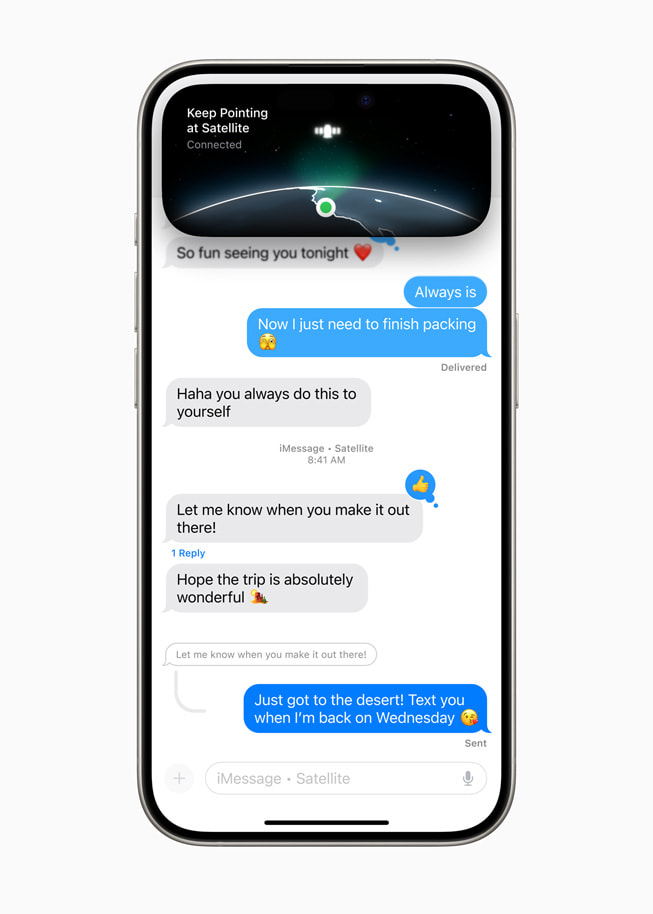
Do you remember when personal locator beacons (PLB) and satellite messenger’s greatest assets were that they had far superior coverage compared to cell phones? That meant that any true hiker or wilderness enthusiast who would be traveling deep into the woods or mountains would need a reliable way to call for help in case of an emergency. Well, that one key feature that PLBs and satellite messengers had an advantage over cell phones is about to go away.
iOS 18, Apple’s upcoming OS (currently in beta testing) includes an update to its satellite communications feature. With the new OS, you’ll be able to send, via satellite, any message, not just emergency ones. So, when you happen to be totally without service, not only can you send an update letting people you’re okay, but you can keep up with your chats as you normally would, Apple stated in a press release. This is a game changer for those who purchase and carry around a PLB or satellite messengers for safety and emergency purposes only.
“We are thrilled to introduce iOS 18. It is a huge release with incredible features, including new levels of customization and capability, a redesigned Photos app, and powerful ways to stay connected with Messages. There are so many benefits for everyone,” Craig Federighi said in a press release, Apple’s senior vice president of Software Engineering.
We live in a society where no one goes anywhere without their cell phones. People will take their phones with them even if they know they are going to the middle of nowhere and know the phone won’t have a signal, does not get service, and there is no WiFi—they will still take their phones with them. People take their cell phones with them no matter where they go and under any conditions, period. Now, iPhones will be able to send messages via satellite which could potentially make PLBs and satellite messengers obsolete.
- Related Article: A.I. is Hitting the Slopes. How Does That Look?

How it will work
Once an iPhone loses a network connection and switches to “SOS only,” people will see a notification on the Lock Screen inviting them to message via satellite. A person does not even need to tap this alert, just start typing a message, and if there’s no service, their iPhone will send it via satellite automatically. A person will know this is happening because there will be a “Satellite” tag next to the “iMessage” tag in the text field in your thread. They might also be clued in because some messages may take quite a while to send and receive, as they’re beaming up to a satellite first before being routed to their destination.
As with Emergency SOS via Satellite, iOS will guide you on angling your iPhone towards the nearest satellite overhead. You’ll need a clear view of the sky, with few (if any) tall obstructions, including trees and buildings. Assuming conditions are correct, however, you’ll be able to message away.
iMessage will come in automatically, even over satellite, so while you might not keep up with the messages as quickly as you normally would, they’ll eventually arrive. However, SMS texts will only work if you initiate the conversation: If an Android friend texts you while you’re out of service, for example, you won’t receive it. But if you send a message, you’ll receive their direct response.
Other features of the new iOS 18 are:
- New Levels of Customization and Capability
- Photos Gets a Unified View, New Collections, and Customization
- Powerful Ways to Stay Connected in Messages
- Enhancements to Mail
- Big Updates to Safari
- Introducing the Passwords App
- New Privacy Features Designed to Empower Users
- Apple Intelligence Transforms the iPhone Experience
With the new iOS 18, Apple now has four features that use its satellite service:
- Messages via satellite
- Emergency SOS via satellite
- Location via satellite
- Roadside Assistance via satellite.
Although Apple added this new feature to the iPhone it does not mean that everyone will immediately stop using or buying other satellite communication devices. Garmin and other satellite communication devices have a longer battery life that can last weeks and even months. As many iPhone users know, its battery life does not last nearly as long and tends to die within hours or a day at best. SAT phones are much more durable to the elements than cell phones such as being cold-resistant, water-resistant, drop-resistant, etc. It is also important to point out SAT phone’s reliability in emergencies. No one wants to have a piece of equipment in an emergency that does not work. SAT phones have proven that they work in those situations and the iPhone still has yet to be tested in them.
Some people can probably remember when everyone had a Garmin mounted to their vehicle’s windshield for directions. Now, almost every car comes standard with a built-in GPS for navigation. Technology changes so quickly and the tech we had last year can become obsolete tomorrow. Being able to send any message via satellite wherever and whenever you want is a game changer for Apple and the iPhone. Trying to stay connected when you did not have a signal or Wi-Fi used to be a problem for cell phone users, but not anymore.
For more information visit Apple’s website.